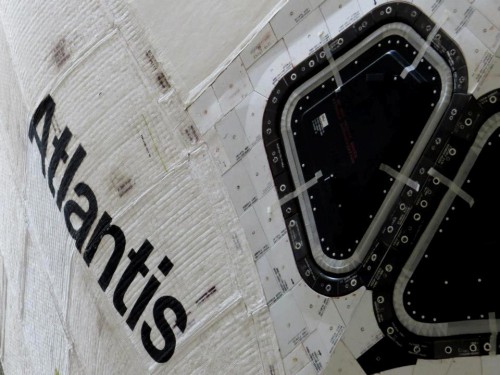
CAPE CANAVERAL, Fla — Space Shuttle Atlantis’ new digs has a new sign in preparation for this summer’s grand unveiling, currently planned to take place June 29, 2013.
On Thursday, Feb. 21, the operators of the Kennedy Space Center Visitor Complex, Delaware North Companies, hosted a tour to highlight the progress that has been made so far in getting the new structure ready to receive guests.
“As you can see from what’s behind me, we’ve made a lot of progress from over a year ago when we broke ground on Space Shuttle Atlantis’ new home,” said the Kennedy Space Center Visitor Complex Chief Executive Officer Bill Moore. “Today is another milestone toward the grand opening.”

Delaware North has taken pains to make sure that the building can not only accommodate Atlantis, but also numerous other elements from the shuttle era. Atlantis is approximately 122 feet long and is about 78 feet wide (about the size of a DC-3 aircraft). The Visitor Complex has positioned the orbiter so that it appears as it did in flight. Placed some 30 feet in the air and inclined 43 degrees, Atlantis’ payload doors will be open and the Canadian robotic arm which served her so well during her active career will be extended. It should be a jaw-dropping display.
Currently, Atlantis looks like nothing so much as a wrapped frozen turkey, ready for Thanksgiving. The shuttle has been encased in a plastic protective covering to prevent the historic spacecraft from being damaged by falling debris as workers prepare her new home to accept guests.

The protective cover will be removed in the middle of May. In the meantime workers are working nearly 20 hours a day to get the structure ready. Of the space shuttles’ new homes, Atlantis’ will be the first to open. Discovery was moved into Shuttle Enterprise’s old position at the Smithsonian’s Steven F. Udvar-Hazy Center, located in Chantilly, Va. Endeavour is currently resting in a temporary facility at the California Science Center. Enterprise, which was a test article for the shuttles and never flew in space, was sent to the Intrepid Sea, Air, and Space Museum in New York and placed in an inflatable structure. This structure failed during Hurricane Sandy and the shuttle was damaged.

This should not be a problem with Atlantis, as the operators of the Visitor Complex have taken every precaution and provided the orbiter with a sturdy structure up to the task of protecting its precious cargo.
Guests who are fortunate enough to see Atlantis at her new home might be a little taken aback by her appearance, and this should serve to reinforce the fact that Atlantis is not a model—she flew into the black 33 times and helped to build the International Space Station and Russia’s Mir space station, as well as serviced the Hubble Space Telescope. In short, they are viewing a rock star of space exploration.
Those elements that made the shuttle ascend into the heavens and history will sit side-by-side with the vehicle that was at the core of the United States’ manned space flight program for 30 years. One of the massive, orange external tanks will be in this new facility, as will the Gaseous Oxygen Vent Arm and its hood—this is often referred to as the “Beanie Cap.” The Beanie Cap was placed over the top of the ET on launch day to vent excess gases during fueling.
“The ‘present’ inside this building might be currently wrapped, but when it is unwrapped it’s uh … it’s a hell of a gift here. It is going to be a heck of a gift for the whole Space Coast,” said Delaware North Companies Parks and Resorts President and former Kennedy Space Center Visitor Complex Chief Operating Officer Rick Abramson. “When I came and saw the Saturn V—at that time in the open in front of the VAB—I asked if that was a real rocket, and I was told yes. There were things living and growing in it, and we took it and refurbished it to like-new. That was a new beginning, and this too will be another new beginning. People will now have an opportunity to closer to this space artifact than ever before at any other place! With this they will gain a better understanding and appreciation of the 30-year history of the space shuttle.”
[youtube_video]http://youtu.be/cPQ96Ib1vyg[/youtube_video]
Video coutesy of Wired4Space
Missions » ISS »




One Comment
One Ping
Pingback:United States and North American News | David Reneke | Space and Astronomy News